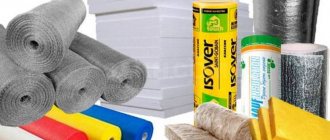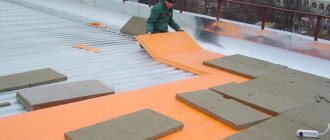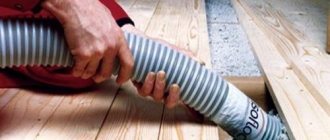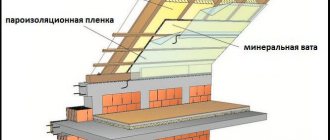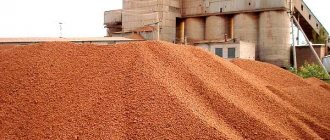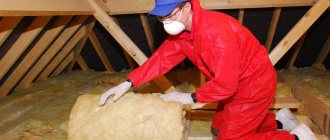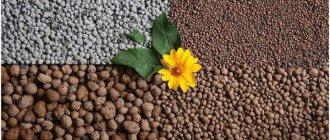Pros and cons of insulating the attic of a house with expanded clay
Expanded clay is not a new product on the construction market. Insulation has been used since the last century. However, its popularity continues to persist due to its many positive qualities.
Expanded clay has been used for insulation of construction sites since the last century.
Expanded clay belongs to the group of bulk thermal insulation. It is used more for insulating horizontal surfaces, which includes the ceiling on the attic side. When thermally insulating vertical structures, additional structures are created that allow backfilling.
Thermal insulation consists of unevenly shaped granules of different sizes. The main manufacturing material is shale clay, which is fired. Each granule forms a hard shell on top and a porous body inside. Due to the presence of air bubbles, the thermal insulation properties increase.
Important! Popular insulation materials, such as polystyrene foam, polyethylene foam, polyurethane foam, etc., are based on the principle of expanded clay porosity.
The main advantages are:
- Fire safety. Since expanded clay is made of clay, even an open fire source is safe for it. Natural material does not emit harmful substances when heated.
- Light weight. Due to their porosity, clay granules are lightweight, which makes it possible to fill the ceiling from the attic side with a thick layer.
- Resistant to damage. The granules are not chewed by mice; they can withstand mechanical loads and are resistant to the destructive effects of fungi and putrefactive microorganisms.
- Ease of use. To insulate any structural element, the material is simply covered with a layer of a certain thickness.
- Long service life. The granules withstand extreme conditions and do not lose their thermal insulation properties after 25 cycles of freezing and thawing.
- Affordable price.
One of the disadvantages is the large dust formation when working with granules. Lifting material into the attic for insulation is problematic. Adaptations and assistants will be required. If the backfill area is large, you will have to hire a crane, which leads to additional costs.
Porosity indicates that the granules absorb moisture. When insulating an attic, the backfill layer on both sides must be covered with a membrane. The material is light, but not so light that a false ceiling can withstand it. The ceiling must be durable or insulation with granules will have to be abandoned.
Characteristics, pros and cons of expanded clay
Expanded clay is small, mostly round, porous pellets of baked clay. Obtained by rapid heating of moistened, fusible clay or clay shale. During the process of evaporation of water, the raw material “boils”, as a result of which numerous pores are formed, which give expanded clay its thermal insulation properties.
Advantages and disadvantages
The material obtained by firing clay has both advantages and disadvantages. Among the advantages it is necessary to highlight:
- low price for 1 m3 of material. However, some clarification is needed here: insulation in small packages is quite expensive. Expanded clay can only be purchased in big bags at an affordable price;
- long service life comparable to the service life of the building as a whole;
- resistance to sudden temperature changes - in domestic conditions it is impossible to create conditions under which destructive processes begin inside the granules;
- does not apply to flammable materials;
- high frost resistance - withstands from 150 to 300 freezing/thawing cycles;
- low specific gravity;
- versatility - can be used as backfill and filler for lightweight concrete;
- environmental safety;
- simple insulation technology;
- resistance against fungus, mold and mice and rats.
Among the disadvantages :
- very high level of water absorption, reaching 25% for whole granules, 40% for damaged ones;
- thermal insulation properties are manifested only when the thermal insulation layer is openly backfilled with a thickness of 200 mm and above;
- a large amount of fine dust penetrating into all cracks during backfilling.
More complete information about expanded clay, with detailed comments about the advantages and disadvantages, can be found in the work “Expanded clay as insulation.”
Characteristics
Expanded clay insulation has a high range of values for all indicators, which is explained by the quality of the clay. Him:
- thermal conductivity - 0.1-0.18 W/(m×°K). 0.23 W/(m×°K) is also found;
- density - 300-800 kg/m3. In St. Petersburg, for locally produced expanded clay, this figure is 1,200 kg/m3;
- compressive strength - 1.0-4.0 mPa.
How to prepare an attic for filling with expanded clay
Before starting work, remove all foreign objects from the attic. If dampness is present, drying is done by creating a draft. They are thinking about a way to lift expanded clay. You may have to remove a couple of sheets of roofing if this cannot be done through the hole into the attic.
The vapor barrier is laid across the joists
Most often, houses are equipped with wooden ceilings. Before filling it with expanded clay, you need to lay a moisture-proof membrane. A vapor barrier, roofing felt or regular film will do. The stripes are laid across the beams. An overlap of 10-15 cm wide is made at the joints. The seams are taped. If roofing felt is chosen for moisture protection, then the tape is not able to reliably fasten the hard edges of the strips. The joints are glued with bitumen mastic or simply liquid bitumen melted over a fire.
To prevent granules from damaging the vapor barrier when filling in thermal insulation, it is first covered with a thin layer of dry powdery clay. The presence of lumps with a diameter of up to 1 cm is allowed. The clay is leveled using the rule. A uniform layer with a thickness of 2 to 5 cm should be obtained over the entire area. At this point, preparation for insulation is completed.
Insulation materials
82 votes
+
Vote for!
—
Vote against!
To ensure that your home is always warm and cozy with the onset of winter, you need to take care of roof insulation in advance. Today, more and more people are choosing expanded clay as insulation. It is widely available and inexpensive, as well as environmentally friendly and has excellent performance characteristics.
- What is expanded clay, its advantages and disadvantages
- Tools and materials required for roof insulation with expanded clay
- Steam and waterproofing for expanded clay
- Roof insulation with expanded clay
What is expanded clay, its advantages and disadvantages
Expanded clay is a lightweight porous material in the form of small granules, obtained by firing clay. It has gained popularity both among professional builders and home craftsmen, thanks to the following technical indicators:
- high heat and noise insulation;
- frost-resistant qualities;
- fireproof qualities;
- strength, resistance to rotting;
- long service life, resistance to temperature changes.
Expanded clay, the price of which is much lower than the price of other thermal insulation materials, can last, unlike them, for many years. Its main advantages are:
- high thermal conductivity;
- light weight;
- not susceptible to chemically aggressive environments;
- does not emit toxic substances into the atmosphere;
- This is the only thermal insulation material that does not require special knowledge, skills and experience when working with it.
But this material also has its drawbacks, although they are few:
- to achieve a high level of heat and sound insulation, you need to lay out the material in a fairly thick layer;
- is not resistant to moisture, therefore, when insulating damp rooms, a special film for waterproofing should be used;
- the material is quite fragile, and damage to the granules leads to a decrease in the quality of thermal insulation.
Tools and materials required for roof insulation with expanded clay
In order to insulate the roof yourself, you will need the following materials and equipment:
- expanded clay for the roof;
- shovel and buckets;
- a log or stick to compact the insulation layer, and a lath to level it;
- waterproofing film;
- roofing felt in rolls;
- sharp knife;
- tiles or tiles for external covering.
Steam and waterproofing for expanded clay
Steam and waterproofing of the insulating layer is an important stage in the construction of the roof, which in no case should be overlooked. As mentioned earlier, expanded clay is capable of absorbing moisture. At the same time, its thermal insulation qualities sharply deteriorate, and it itself becomes much heavier than in dry form. This can lead to dire consequences, including the collapse of the ceiling. Thus, if the expanded clay layer is allowed to become wet, the service life of the roof can be sharply reduced, and repairs will be required much earlier than planned.
None of the existing types of thermal insulation materials can properly protect a room from the cold unless it itself is protected by vapor and waterproofing. Vapor barrier material is usually installed on the inside of the room, because it protects the insulation from vapors arising inside the room, and the waterproofing is installed from the outside, because it protects the insulation from moisture coming from the street.
The most common waterproofing materials are films and membranes. Materials such as styrofoam, polyethylene film, foil, glassine are also very often used.
Styrofoam is a type of foam plastic and has excellent vapor barrier properties. Glassine is roofing cardboard impregnated with bitumen. It is sold in rolls and is very good for waterproofing roofs. Foil and plastic film are often used to protect against condensation because liquid does not accumulate on them.
Roof insulation with expanded clay
Most often, when insulating roofs, builders use the following types of expanded clay:
- expanded clay crushed stone is a large material with granules up to 4 cm in size. It is equally good for insulating the roof, as well as for insulating the floor and walls;
- expanded clay gravel is also a coarse-grained material, the granules of which also reach 4 cm in size and have an angular shape;
- Expanded clay sand is a finely dispersed material, the particles of which are no more than 5 mm in size. It is used as thermal insulation, in which the layer thickness does not exceed 5 cm.
It is quite possible to insulate the roof yourself if you cannot pay specialists.
Before starting work, it is necessary to study some features of the insulation process. First of all, you should pay attention to the design features of the building, its walls and roof. The insulation process should consist of several stages:
- internal lining;
- vapor barrier;
- laying insulation;
- surface finishing.
Description of works:
- When insulating a roof with expanded clay, the thickness of the layer of material should be 25 cm. It is poured directly onto the vapor barrier film in the required quantity quickly and accurately to avoid damage to the granules.
- For good heat and sound insulation, it is better to pour a thicker layer, but it is important not to forget about the maximum load that the roof can withstand. In this matter it is better to stick to the golden mean.
- Then the expanded clay is carefully leveled and compacted so that there are as few voids as possible between its particles. This is done either by hand or using a special machine. It is advisable to make a screed on top of the first layer to give additional rigidity and strength to the entire structure, as well as to level the surface.
- Also, between the outer and inner layers, several channels should be installed through which air will circulate and excess moisture will be removed.
- Next, a rolled roofing material is placed directly on the insulating layer, which will press it down with its weight. It should overlap and have no gaps. At the same time, to ensure the tightness of the seams, it is better to insulate them using construction tape or bitumen mastic.
- The next step is to lay tiles or tiles.
Many companies engaged in the sale of building materials, as well as shops and construction hypermarkets offer to buy expanded clay.
How to lift expanded clay into the attic
The difficulty of insulation is associated with the supply of thermal insulation to the attic. You need a lot of bulk material. Special machines are used in production. At home, they come up with various devices.
Special machines in production help to quickly feed expanded clay to heights in large quantities
To ensure effective insulation, it is optimal to use expanded clay of three fractions. The granules are mixed before being placed into the attic. They do it on the ground. The presence of granules of different sizes will make it possible to obtain a dense and even layer of insulation.
Various devices are used to supply bulk materials to the attic in private construction. Most often, a block is hung on a beam. A rope with a hook is used to hook the buckets. You will need at least two assistants: one loads on the ground, and the other scatters the insulation over the ceiling. To speed up the process, you can use a block to lift not buckets, but a larger capacity container, for example, a trough.
If expanded clay is purchased packaged in bags, lifting it into the attic is simplified. There is no need to load it on the ground. You just need to pick up the bags and lift them with a block. Another device is a soft container. It is made from a piece of durable tarpaulin. Loops are made at the four corners and ropes are attached. The four free ends are tied with a knot. It looks like a hammock. At one time, a durable tarpaulin can lift up to 100 kg of pellets.
If the attic is large, it is difficult to lift huge amounts of building material by hand. Here it is optimal to use the service of a crane. However, several sheets of roofing will have to be removed, since the supply will be carried out through the roof.
Thickness of expanded clay layer for attic insulation
Insulation will be effective only if the layer thickness is correctly calculated. The parameter depends on the climatic conditions of the region, the material of the ceiling, and the design of the roofing pie. The minimum layer of expanded clay for insulating an attic is 15-20 cm. However, such parameters are acceptable for buildings located in the southern regions. It is desirable to have a warm roof and a wooden ceiling. Wood also has good thermal insulation properties, which makes it possible to reduce the thickness of the expanded clay backfill.
The thickness of the insulation backfill depends on the climate of the region and the design features of the roof.
For cold areas, such a layer thickness for the attic is unacceptable. The same applies if the floor is concrete and the roof is cold. Effective insulation can be achieved by increasing the layer thickness to 30-40 cm.
When calculating the thickness of the insulation, the strength of the floor is taken into account. Depending on the fraction, the mass of 1 m3 of expanded clay varies from 250 to 450 kg. Expanded clay sand is the heaviest, but it is not needed for insulating the attic. The ceiling must withstand the load at a certain layer thickness.
Expanded clay
It is a lightweight material whose structure includes many pores, which determines its high thermal insulation properties. It is produced by firing clay shales or clay itself at high temperatures (1000-1300 degrees) for quite a long time (20-40 minutes). Depending on the type of feedstock and processing technology, the density of the resulting expanded clay can range from 0.35 to 0.6 g/cm3.
There are the following types (depending on the shape of the fragments):
- Expanded clay gravel. It consists of cellular elements of a streamlined oval shape, their size varies from 5 to 40 mm in diameter. Typically, this type is used when there is a need to create a layer of insulation over 5 centimeters.
- Expanded clay crushed stone. The size of the pieces is approximately similar to expanded clay gravel, but their shape is more like a cube, the edges and corners of which protrude sharply. The technology for its production comes down to crushing larger fragments of expanded clay.
- Expanded clay sand. The particle size ranges from approximately 14 to 50 millimeters. The peculiarity of this type of building material makes it possible to create a layer of thermal insulation less than 5 centimeters thick without losing its insulating qualities. In addition, it is used in the range of 14-50 millimeters. Small dimensions allow the use of expanded clay sand with a heat-insulating layer thickness not exceeding 5 centimeters. It is also used as a filler for concrete or other mortar.
A ten-centimeter layer of such insulation is comparable in its heat-insulating properties to a wooden beam, 25 centimeters thick, a slab of expanded clay concrete, 60 centimeters thick, or a meter of brickwork. When using a layer over 15 centimeters, you can achieve the maximum insulating effect. This type of insulation is also economically beneficial, since the cost of purchasing it will be several times lower compared to other types of insulation. Expanded clay will cost 10 times less than brick, and 3 times more economical than wood.
Advantages of expanded clay
This thermal insulation material is very economical. When using expanded clay, you can sound and heat insulate your home with the least investment of money. The material has a high fire safety rating and a high degree of environmental friendliness, since various types of clay are used for its production. It also has a significant service life. This is due to the fact that the material does not condense moisture.
This insulation has a crumbly structure and consists of countless pores, which prevents the appearance of rodents and insects in it. One of the key advantages of expanded clay is its increased resistance to high temperatures. In this regard, the material is suitable for installation in extreme climatic conditions. Using expanded clay, you can achieve a high level of noise insulation, which is a big plus for work on the upper floors of buildings.
Any material used for construction must meet environmental safety requirements. Expanded clay is made exclusively from pure clay, which does not contain various chemical additives. Therefore, it is completely safe for human health. In the production of oval varieties of expanded clay, clay is fired.
How to insulate an attic floor with expanded clay
The technology depends on the overlap device. Expanded clay can be used on concrete surfaces and on beams. Insulation of suspended ceilings and other types of weak floors is not performed with granules.
On a concrete floor, it is optimal to lay expanded clay under the screed
To insulate attic floor slabs with expanded clay, the concrete surface is covered with waterproofing bitumen mastic. Beacons are installed along it, making it possible to maintain the same thickness of the backfill. If the attic will not be walked on or used for storing things, it is enough to cover the insulation on top with film. The joints of the sheets are sealed with tape.
More reliable insulation will be obtained with a screed. The granules are filled with cement laitance. The attic is dried for at least a week, creating a good draft. A reinforcing metal mesh is laid on the insulation and filled with a concrete screed about 4 cm thick. You can move on such a surface and use the attic as a storage area for equipment.
On a wooden floor, backfilling is carried out between the beams
To insulate an attic with expanded clay for a wooden floor, a vapor barrier is laid over the beams. On the room side, the ceiling should be lined with a solid board. She will play the role of the subfloor. Expanded clay is poured between the joists. The top of the insulation is covered with a vapor barrier. If the attic is to be used, after insulation, plank flooring is laid over the beams.
Layer thickness
The thicker the insulation, the higher its thermal insulation characteristics, but we should not forget about the maximum loads for the structure.
The approximate thickness of the backfill is chosen to be within 25–40 cm; if you err on the smaller side, after the first winter you will have to additionally insulate the ceiling in the room. To prevent this from happening, before starting work, you should calculate the thickness of the expanded clay backfill using the formula P = R × k, where R is the thermal resistance of the structure determined according to SNiP, k is the thermal conductivity coefficient of expanded clay (equal to 0.16 W/m).
